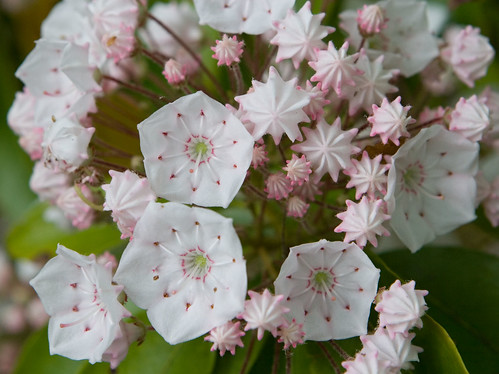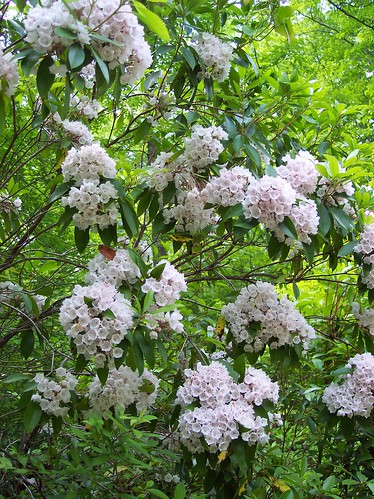 The buds of mountain laurels look like an old-fashioned candy. They open up into a cup-shaped flower made of five petals that are fused together. The flowers are usually a very faint pink, but you may see cultivated varieties with darker flowers.
The buds of mountain laurels look like an old-fashioned candy. They open up into a cup-shaped flower made of five petals that are fused together. The flowers are usually a very faint pink, but you may see cultivated varieties with darker flowers.They may look pretty, but mountain laurel flowers are quite sneaky. The ten stamens of each flower start out tucked into little dimples in the petals. As a bee lands on the flower, the stamens spring out of their dimples, releasing their pollen. Try springing the trap yourself, or sit and watch: a bee is sure to come along.
Mountain laurel is in the genus Kalmia, named after Peter Kalm, a Finnish-Swedish naturalist. Kalm came to North America in 1748 to look for plants that might have agricultural uses in Europe; he brought back hundreds of specimens. In writing about mountain laurel, Kalm described the uses that Native Americans and colonists had for the plant. The wood, while usually not thick, is strong, and was used for pulleys, spoons, and trowels; the leaves were used as a medicinal skin wash.
 In the wild: There is a nice stand of mountain laurel in Rock Creek Park on the Valley Trail, north of Holly St., after you go up a big hill (map; previous post), and another on the Rachel Carson Greenway Trail along the Northwest Branch of the Anacostia, just north of Colesville Road (map; previous post). I'm sure there are others: keep an eye out on north-facing slopes, and post other sightings in the comments below.
In the wild: There is a nice stand of mountain laurel in Rock Creek Park on the Valley Trail, north of Holly St., after you go up a big hill (map; previous post), and another on the Rachel Carson Greenway Trail along the Northwest Branch of the Anacostia, just north of Colesville Road (map; previous post). I'm sure there are others: keep an eye out on north-facing slopes, and post other sightings in the comments below.In your yard: Mountain laurels can be hard to get established. They want very acidic soil that remains cool and moist. We've never had any luck getting one to survive, but we do know a few yards with successful plantings.
Sources for this post:
Richard Jaynes, Kalmia: Mountain Laurel and Related Species
William Cullina, Native Trees, Shrubs, and Vines: A Guide to Using, Growing, and Propagating North American Woody Plants


